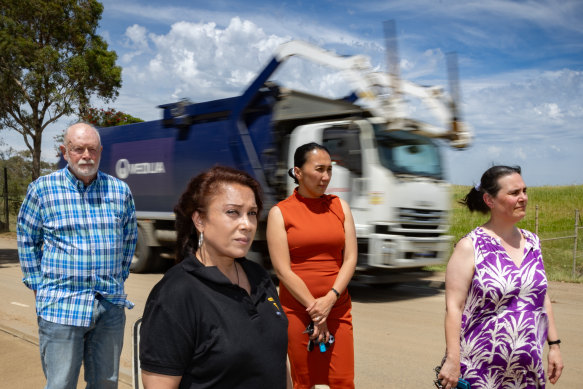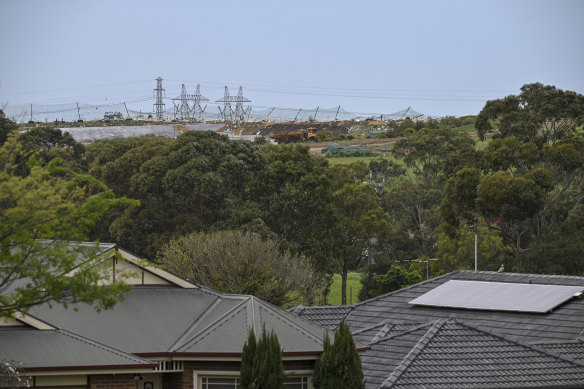By Adam Carey
A contentious waste transfer station that will operate just 250 metres from homes has been approved by the City of Casey just days before its administrators are due to be replaced by a new elected council.
The move has shocked and angered Hampton Park locals already upset about global waste giant Veolia’s management of the site, which currently operates as a major landfill for Melbourne’s south-east.

Newly elected Casey councillor Lynette Pereira (second from left) picture with Lynbrook residents Viv Paine, Vernadette Dickson and Cassandra Duncan, is shocked at the timing of the council’s approval decision.Credit: Jason South
The proposed new facility is expected to receive hundreds of thousands of tonnes of household rubbish every year for 25 years from at least 10 eastern suburbs councils, including Casey, all of which have signed long-term agreements to send their rubbish to be incinerated and converted to energy in the Latrobe Valley.
In August, the Environment Protection Authority (EPA) also introduced new, tighter guidelines for operating a waste transfer station in Victoria, which state that industrial sites that produce odour should be located at least 500 metres from homes.
The prospect of a bigger buffer zone was central to the administrators’ decision in February to defer a decision about whether to approve Veolia’s proposal for the non-recyclable rubbish facility.
More than 1000 homes stand within the new buffer zones, but the City of Casey said it has now decided to issue a permit because Veolia has prepared a risk assessment stating it will meet certain conditions.

Veolia’s Hallam Road landfill is situated close to homes. The company is alleged to have failed to safely manage methane gas emissions.Credit: Eddie Jim
In a statement, Casey said the proposed waste transfer station building is set back 250 metres from the nearest homes and would include exhaust ventilation to improve dispersion of emissions.
“The building is to be fitted with rapid shutter doors designed to reduce offsite odours. Building materials such as concrete wall slabs and roof sandwich panels are designed to reduce noise impacts,” it said.
Veolia still needs a separate works approval from the EPA before it can begin to build the facility.
The City of Casey has been governed by administrators since 2020, when the previous council was sacked amid one of Victoria’s worst corruption scandals.
Casey residents voted to elect a new council last month. Two municipal monitors will oversee the new council for its first 12 months.
Lynette Pereira, an independent candidate who won election in River Gum Ward, which covers the suburbs near the landfill, said it was unacceptable for the administrators to issue a permit now.
“I’m utterly shocked that this has been pushed through just before councillors get on board,” Pereira said. “These are not elected officials. They don’t care about the community the way we do. They are there to perform an administrative function.”
Pereira said the waste transfer station, once operational, would affect residents both in and outside the expanded buffer zone.
“We’re talking about four suburbs, not just the people in the buffer zone … And we’re talking about trucks carrying many tonnes of rubbish, putrescible rubbish and other commercial waste, operating 18 hours a day.”
Residents living close to the landfill were informed by email on Monday evening of Casey’s decision.
Lynbrook Residents Association secretary Dish Johnson said: “Our community faces a shocking and deeply unjust decision by Casey Council.”
In a letter sent to City of Casey chief executive officer Glenn Patterson, and shared with The Age, Johnson said it was troubling that the community was notified on the eve of a public holiday and on the cusp of a new council being elected.
“This rushed approval, hidden from public notice and stripped of our right to appeal, raises serious questions about transparency, accountability and whose interests are truly being served here.”
The current landfill site was the subject of more than 1500 community complaints to the EPA about odour in 2022-23. Veolia is being pursued in the Supreme Court by the EPA for allegedly allowing methane gas emissions to exceed safe levels at the facility on 22 occasions over two years.
Patterson said the new site “will play a crucial role in supporting Victoria’s sustainability goals”.
“We understand that the local community may be disappointed by this decision,” he said. “Council’s role is to consider planning permit applications against relevant policies, development plans and legislation, and to ensure local amenity is protected for the community.”
A Veolia spokesperson said the proposed station “will be a $40 million state-of-the-art facility, designed to address Victoria’s growing waste management needs.
“It’s an important piece of infrastructure for the future as landfill nears capacity across the state.”
The Hampton Park landfill was previously meant to be rehabilitated into parkland once it closed. But that plan was scrapped in 2022, after the Andrews government identified the site as a significant hub for waste management.
The proposed waste transfer station is also key to plans of at least 11 councils to dispose of their non-recyclable rubbish.
Veolia and Opal Australian Paper, which owns a paper mill in Gippsland’s Maryvale, secured a waste supply agreement with 10 councils in Melbourne’s east in August.
Those councils – Casey, Bayside, Cardinia, Greater Dandenong, Frankston, Kingston, Knox, Maroondah, Whitehorse and Yarra Ranges – have committed to supply their non-recyclable waste to the plant for 25 years. Latrobe City Council has also agreed to supply waste to the plant.
The energy-from-waste plant will initially have capacity to process 325,000 tonnes of rubbish a year.